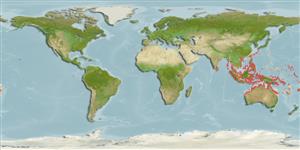Teleostei (teleosts) >
Kurtiformes (Nurseryfishes, cardinalfishes.) >
Apogonidae (Cardinalfishes) > Apogoninae
More on authors: Smith & Radcliffe.
Environment: milieu / climate zone / depth range / distribution range
Ecology
Marine; reef-associated; depth range 2 - 20 m (Ref. 37816). Tropical; 30°N - 24°S
Indo-West Pacific: Malaysia east to Palau in Micronesia and the Solomon Islands, north to the Ryukyu Islands and south to the Great Barrier Reef.
Size / Weight / Age
Maturity: Lm ? range ? - ? cm
Max length : 12.0 cm TL male/unsexed; (Ref. 9710); common length : 8.5 cm SL male/unsexed; (Ref. 37816)
Dorsal spines (total): 8; Dorsal soft rays (total): 9; Anal spines: 2; Anal soft rays: 9. Color is white or pinkish with about six red-brown stripes on side; 3-4 dark spots at the base of the caudal fin. Eyes iridescent blue. Small juveniles have yellow caudal peduncle with black spot in centre, mimicking the large-toothed Cheilodipterus species. That enables them to swim about more freely (Ref. 48635).
Found in small aggregates among or near mounds of branching corals such as Porites cylindrica or P. nigrescens (Ref. 1602). Nocturnal species (Ref. 7300). Has been reared in captivity (Ref. 35404).
Life cycle and mating behavior
Maturity | Reproduction | Spawning | Eggs | Fecundity | Larvae
Mouthbrooders (Ref. 240). Distinct pairing during courtship and spawning (Ref. 205).
Myers, R.F., 1991. Micronesian reef fishes. Second Ed. Coral Graphics, Barrigada, Guam. 298 p. (Ref. 1602)
IUCN Red List Status (Ref. 130435: Version 2024-1)
Threat to humans
Harmless
Human uses
Fisheries: of potential interest; aquarium: potential
Tools
Special reports
Download XML
Internet sources
Estimates based on models
Preferred temperature (Ref.
123201): 26.6 - 29.3, mean 28.7 °C (based on 2141 cells).
Phylogenetic diversity index (Ref.
82804): PD
50 = 0.5000 [Uniqueness, from 0.5 = low to 2.0 = high].
Bayesian length-weight: a=0.00955 (0.00512 - 0.01780), b=3.06 (2.90 - 3.22), in cm total length, based on LWR estimates for this species & (Sub)family-body (Ref.
93245).
Trophic level (Ref.
69278): 3.5 ±0.50 se; based on food items.
Resilience (Ref.
120179): High, minimum population doubling time less than 15 months (Preliminary K or Fecundity.).
Fishing Vulnerability (Ref.
59153): Low vulnerability (10 of 100).
Nutrients (Ref.
124155): Calcium = 126 [78, 217] mg/100g; Iron = 0.95 [0.59, 1.49] mg/100g; Protein = 19.1 [18.1, 20.1] %; Omega3 = 0.158 [0.101, 0.248] g/100g; Selenium = 26.4 [14.9, 47.5] μg/100g; VitaminA = 90.5 [33.3, 242.3] μg/100g; Zinc = 1.86 [1.28, 2.59] mg/100g (wet weight);
